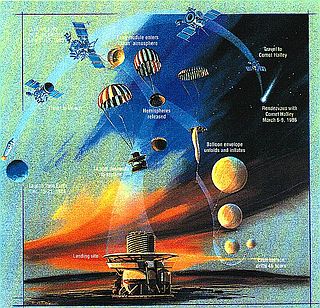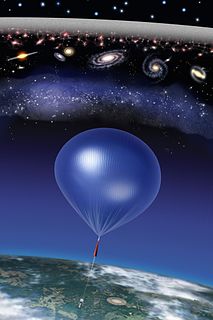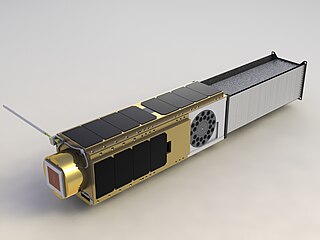Related Research Articles

An aerobot is an aerial robot, usually used in the context of an unmanned space probe or unmanned aerial vehicle.

The Vega program was a series of Venus missions that also took advantage of the appearance of comet 1P/Halley in 1986. Vega 1 and Vega 2 were uncrewed spacecraft launched in a cooperative effort among the Soviet Union and Austria, Bulgaria, France, Hungary, the German Democratic Republic, Poland, Czechoslovakia, and the Federal Republic of Germany in December 1984. They had a two-part mission to investigate Venus and also flyby Halley's Comet.

The Discovery Program is a series of solar system exploration missions funded by the US National Aeronautics and Space Administration (NASA) through its Planetary Missions Program Office. The cost of each mission is capped at a lower level than missions from NASA's New Frontiers or Flagship Programs. As a result, Discovery missions tend to be more focused on a specific scientific goal rather than serving a general purpose.

High-altitude balloons are crewed or uncrewed balloons, usually filled with helium or hydrogen, that are released into the stratosphere, generally attaining between 18 and 37 km above sea level. In 2002, a balloon named BU60-1 reached a record altitude of 53.0 km.
The Extreme Universe Space Observatory onboard Japanese Experiment Module (JEM-EUSO) is the first space mission concept devoted to the investigation of cosmic rays and neutrinos of extreme energy (E > 5×1019 eV). Using the Earth's atmosphere as a giant detector, the detection is performed by looking at the streak of fluorescence produced when such a particle interacts with the Earth's atmosphere.
Kentucky Space is a non-profit consortium of private and public universities, companies, and other organizations with the goal of designing and leading innovative space missions within realistic budgets and objectives. The enterprise is supported by the Kentucky Space Grant Consortium and developed out of the programs of the Kentucky Science and Technology Corporation.

Absolute Radiometer for Cosmology, Astrophysics, and Diffuse Emission (ARCADE) is a program which utilizes high-altitude balloon instrument package intended to measure the heating of the universe by the first stars and galaxies after the big bang and search for the signal of relic decay or annihilation. In July 2006 a strong residual radio source was found using the radiometer, approximately six times what is predicted by theory. This phenomenon is known as "space roar" and remains an unsolved problem in astrophysics.

The O/OREOS is an NASA automated CubeSat nanosatellite laboratory approximately the size of a loaf of bread that contains two separate astrobiology experiments on board. Developed by the Small Spacecraft Division at NASA Ames Research Center, the spacecraft was successfully launched as a secondary payload on STP-S26 led by the Space Test Program of the United States Air Force on a Minotaur IV launch vehicle from Kodiak Island, Alaska on 20 November 2010, at 01:25:00 UTC.

Space research is scientific study carried out in outer space, and by studying outer space. From the use of space technology to the observable universe, space research is a wide research field. Earth science, materials science, biology, medicine, and physics all apply to the space research environment. The term includes scientific payloads at any altitude from deep space to low Earth orbit, extended to include sounding rocket research in the upper atmosphere, and high-altitude balloons.

The Balloon Rapid Response for ISON (BRRISON) was a NASA project involving a stratospheric balloon with science instruments intended to study comet C/2012 S1 (ISON) and other celestial objects.

ASTERIA was a miniaturized space telescope technology demonstration and opportunistic science mission to conduct astrophysical measurements using a CubeSat. It was designed in collaboration between the Massachusetts Institute of Technology (MIT) and NASA's Jet Propulsion Laboratory. ASTERIA was the first JPL-built CubeSat to have been successfully operated in space. Originally envisioned as a project for training early career scientists and engineers, ASTERIA's technical goal was to achieve arcsecond-level line-of-sight pointing error and highly stable focal plane temperature control. These technologies are important for precision photometry, i.e., the measurement of stellar brightness over time. Precision photometry, in turn, provides a way to study stellar activity, transiting exoplanets, and other astrophysical phenomena.

The Atmospheric Remote-sensing Infrared Exoplanet Large-survey (ARIEL) is a space telescope planned for launch in 2028 as the fourth medium-class mission of the European Space Agency's Cosmic Vision programme. The mission is aimed at observing at least 1000 known exoplanets using the transit method, studying and characterising the planets' chemical composition and thermal structures. Compared to the James Webb Space Telescope, ARIEL will have more observing time available for planet characterisation but a much smaller telescope and it will be launched almost a decade later.

The Time-Resolved Observations of Precipitation structure and storm Intensity with a Constellation of Smallsats (TROPICS) mission is a constellation of six small satellites that will measure temperature and moisture profiles and precipitation in tropical systems with unprecedented temporal frequency. This data will enable scientists to study the dynamic processes that occur in the inner core of the storm resulting in rapid genesis and intensification. William Blackwell of the Massachusetts Institute of Technology's Lincoln Laboratory in Lexington, Massachusetts is the principal investigator. The constellation will be delivered to orbit on three launches between March and May 2022.
Cosmic Vision is the third campaign of space science and space exploration missions in the Science Programme of the European Space Agency (ESA). Formulated in 2005 as Cosmic Vision: Space Science for Europe 2015–2025, the campaign succeeded the Horizon 2000 Plus campaign and envisioned a number of missions in the fields of astronomy and solar system exploration beyond 2015. Ten missions across four funding categories are planned to be launched under Cosmic Vision, with the first being CHEOPS in December 2019. A mission to the Galilean moons (JUICE), the first deep space mission with an opportunistic target, and one of the first gravitational-wave space observatories (LISA), are planned for launch as part of the Cosmic Vision campaign.
Science-Enabling Technologies for Heliophysics (SETH) is a proposed space mission by NASA's Goddard Space Flight Center to launch a small satellite that would demonstrate new technologies to detect solar energetic particles, and demonstrate an optical communication system based on laser pulses.
Abigail Goodhue Vieregg is a professor of physics at the Enrico Fermi Institute and Kavli Institute of Cosmology, University of Chicago, specializing in neutrino astrophysics and cosmology. Her work focuses on cosmic high-energy neutrinos and mapping the cosmic microwave background.

The Compton Spectrometer and Imager (COSI) ,is a gamma-ray telescope expected to launch in 2025 as NASA's latest small astrophysics mission. It is intended to he recent history of star birth, star death, and the formation of chemical elements in the Milky Way.
References
- ↑ "Astrophysics Pioneers | Science Mission Directorate". science.nasa.gov. Retrieved 2021-11-13.
- ↑ "Potentially mind-blowing secrets of the universe could be exposed with new NASA missions". SYFY Official Site. 2021-01-15. Retrieved 2021-11-13.
- ↑ "Antarctic balloon mission chosen for NASA Pioneers program | Penn State University". www.psu.edu. Retrieved 2021-11-13.